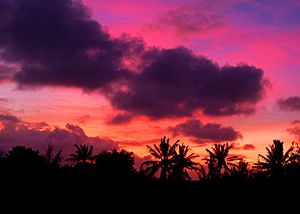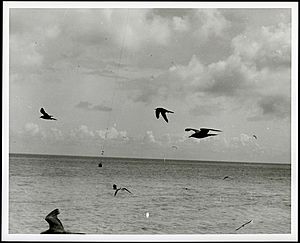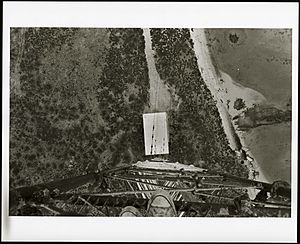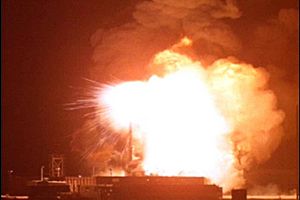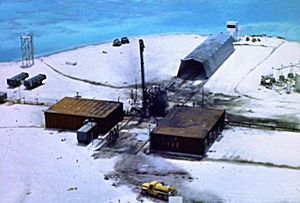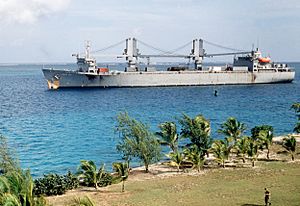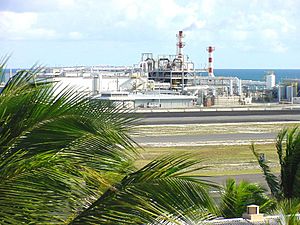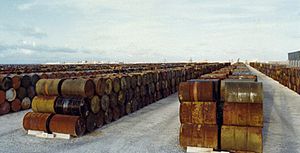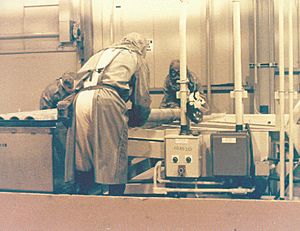Johnston Atoll facts for kids
Quick facts for kids
Johnston Atoll
Kalama Atoll
|
||
|---|---|---|
|
||
| Anthem: "The Star-Spangled Banner" | ||
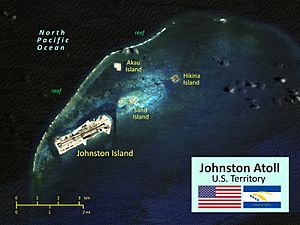
Map of Johnston Atoll
|
||
| Country | United States | |
| Status | unorganized, unincorporated territory | |
| Claimed by U.S. | March 19, 1858 | |
| Government | ||
| • Type | administered as a National Wildlife Refuge | |
| • Body | United States Fish and Wildlife Service | |
Johnston Atoll, also known as Kalama Atoll to Native Hawaiians, is a small group of islands that belong to the United States. It is managed by the United States Fish and Wildlife Service. Johnston Atoll is a special place called a National Wildlife Refuge, which means people cannot visit it without special permission.
For almost 70 years, the U.S. military used the atoll for many different things. It was a place for ships to refuel, an airbase, and a site for testing weapons. It was also used to store and get rid of chemical weapons and Agent Orange. Because of these activities, the area became polluted, and efforts are still ongoing to clean it up and monitor the environment.
Contents
- History of Johnston Atoll
- Johnston Atoll: A National Wildlife Refuge
- Wildlife
- Military Control and Activities
- Nuclear Testing Site
- Test Failures and Contamination
- Biological Warfare Testing
- Chemical Weapon Storage and Destruction
- Agent Orange Storage
- Chemical Weapon Demilitarization
- Closure and What Remains
- Contamination and Cleanup Efforts
- After Closing
- Images for kids
- See also
History of Johnston Atoll
The first time Westerners recorded seeing Johnston Atoll was on September 2, 1796. An American ship called the Sally accidentally ran aground near the islands. The ship's captain, Joseph Pierpont, wrote about his experience, giving a good idea of where the islands were. However, he did not name the area. Local Hawaiian tribes called the islands "iwi poʻo mokupuni."
The islands were officially named on December 14, 1807, by Captain Charles J. Johnston of the British ship HMS Cornwallis.
In 1856, the U.S. Congress passed the Guano Islands Act. This law allowed U.S. citizens to claim islands that had guano (bird droppings used as fertilizer). In 1858, two men, William Parker and R. F. Ryan, found guano on Johnston Atoll and claimed it for the United States.
At the same time, the Kingdom of Hawaii also claimed the atoll. In June 1858, a Hawaiian sailor named Samuel Allen took down the U.S. flag and raised the Hawaiian flag. He renamed the atoll Kalama.
By 1890, most of the guano on the atoll had been dug up and used. In 1892, a British ship surveyed the island to see if it could be a good place for a telegraph cable station. In 1909, the Territory of Hawaii leased Johnston Atoll to a private person for 15 years. They tried to collect more guano, but there wasn't enough good quality guano to make it worthwhile, so the project was soon stopped.
Johnston Atoll: A National Wildlife Refuge
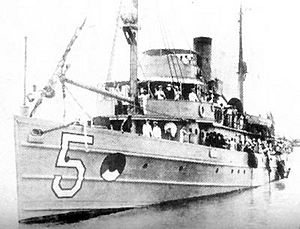
The Tanager Expedition was a scientific trip in 1923, sponsored by the U.S. Department of Agriculture and the Bishop Museum of Hawaii. They visited Johnston Atoll to study its plants and animals. They took the first aerial photographs of the atoll and made a detailed survey. They found many seabirds, lizards, insects, and crabs. The waters around the atoll were full of fish and other sea creatures.
On June 29, 1926, President Calvin Coolidge made Johnston Island Reservation a federal bird refuge. This meant it was a protected area for native birds to live and breed. It was put under the control of the U.S. Department of Agriculture.
In 1940, it was renamed the Johnston Island National Wildlife Refuge. The main goal of the refuge is to protect the tropical ecosystem and all the wildlife that lives there.
However, the Department of Agriculture did not have ships, and the United States Navy was interested in the atoll for military reasons. So, on December 29, 1934, President Franklin D. Roosevelt put the islands under the control of the Secretary of the Navy. It was still meant to be a bird refuge, but the Navy also had control.
On February 14, 1941, President Franklin Roosevelt created special naval defense areas in the Pacific. This included the "Johnston Island Naval Defensive Sea Area" and "Johnston Island Naval Airspace Reservation." This meant only U.S. government ships and aircraft could enter these areas unless the Secretary of the Navy gave permission.
In 1990, two full-time staff from the U.S. Fish and Wildlife Service were stationed on Johnston Atoll. They helped manage the wildlife and deal with pollution issues.
After the military left the island in 2004, the atoll became part of the Pacific Remote Islands Marine National Monument. This monument was created by President George W. Bush in 2009 to protect Johnston Island and other Pacific islands. In 2014, President Barack Obama made the protected area even larger, banning all commercial fishing.
Wildlife
About 300 types of fish live around the reefs and waters of Johnston Atoll. Green turtles and Hawaiian monk seals also visit the atoll. Many kinds of seabirds breed there, including Bulwer's petrel, wedge-tailed shearwater, Christmas shearwater, and different types of boobies and terns.
Migratory shorebirds also stop at Johnston Atoll, such as the Pacific golden plover and ruddy turnstone. It's thought that humpback whales might use the waters for breeding, though not very often. Other whales may pass through the area, and Cuvier's beaked whales have been seen there.
Military Control and Activities
On December 29, 1934, President Franklin D. Roosevelt gave control of Johnston Atoll to the United States Navy. They wanted to build an air station there. In 1948, the United States Air Force (USAF) took over control of the atoll.
From 1963 to 1970, the Navy and the Atomic Energy Commission (AEC) shared control of the island. They used it for high-altitude nuclear testing.
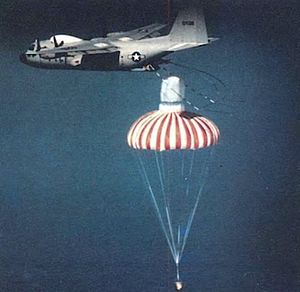
After 1970, the Air Force again had control until 1973. Then, different defense agencies managed the island over the years, including the Defense Nuclear Agency and the Defense Threat Reduction Agency. In 1999, the Air Force took back control until their mission ended in 2004, and the base was closed.
Nuclear Testing Site
Between 1958 and 1975, Johnston Atoll was used by the U.S. for nuclear tests. These tests included explosions high up in the atmosphere and even in outer space. In 1958, two nuclear tests, called "Hardtack I," happened near Johnston Atoll. Very powerful hydrogen bombs were launched by rockets to high altitudes and exploded.
Johnston Island was also a launch site for many sounding rockets. These rockets carried scientific tools to gather information during the nuclear tests or to experiment with anti-satellite technology.
In 1962, eight PGM-17 Thor missiles were launched from Johnston Island as part of "Operation Fishbowl." This was a series of nuclear weapons tests in the Pacific. Four of these tests resulted in successful high-altitude explosions, including "Starfish Prime."
"Starfish Prime" happened on July 9, 1962. A very powerful explosion occurred about 400 kilometers (250 miles) high. It created a bright flash that could be seen over a large area and also bright artificial auroras (like the Northern Lights) visible in Hawaii. This explosion also caused an electromagnetic pulse that affected some electric power and communication systems in Hawaii. It also damaged or destroyed seven satellites in orbit.
The last test of Operation Fishbowl was "Tightrope" on November 3, 1962. It was a smaller explosion at a lower altitude. This was the final American nuclear test in the atmosphere.
Test Failures and Contamination
The "Fishbowl" test series had four failures. One test, "Bluegill," had to be destroyed after launch because of a problem. The missile fell into the ocean, but the nuclear material was not released onto the island.
However, other test failures, like "Starfish," "Bluegill Prime," and "Bluegill Double Prime" in 1962, scattered radioactive material over Johnston Island. This caused serious contamination to the island, the lagoon, and nearby Sand Island, especially with plutonium.
"Starfish" was the first test to contaminate the atoll. The rocket carrying the nuclear device had a problem shortly after launch and was destroyed. Pieces of the missile, including parts with plutonium, fell back onto Johnston Island and Sand Island.
"Bluegill Prime" on July 25, 1962, was a major disaster. The missile had a problem right after it started, and it was destroyed while still on the launch pad. The launch area was destroyed in explosions and fire. The explosion and wind spread radioactive plutonium over the launch site and parts of the island.
After this accident, nuclear testing stopped. The launch complex was badly damaged and contaminated. Troops were sent in to quickly clean up the area. They removed contaminated soil and debris. Some of this contaminated material was dumped into the lagoon, polluting the ocean. More than 550 drums of contaminated material were also dumped into the ocean from 1964 to 1965.
The lagoon was dredged (dug up) again in 1963–1964 to make Johnston Island larger. This process spread more contamination to other parts of the island.
On October 15, 1962, the "Bluegill Double Prime" test also failed. The rocket was destroyed high in the air after a malfunction. This also added to the radioactive pollution on the island.
In 1963, the U.S. agreed to the Partial Nuclear Test Ban Treaty. This treaty stopped most nuclear tests in the atmosphere. Johnston Atoll was kept ready as a testing site in case atmospheric tests ever needed to happen again, but this mission ended in 1993.
Biological Warfare Testing
In 1965, Johnston Atoll was used for testing defenses against biological warfare. The tests involved releasing harmless substances to see how they would spread and how ships could protect themselves. This was part of a project to understand how to defend against biological agents.
Chemical Weapon Storage and Destruction
In 1970, Congress decided that the island's military job would be to store and destroy chemical weapons. The United States Army leased part of the atoll to store chemical weapons from Okinawa, Japan. Johnston Atoll became a storage site for about 6.6 percent of the U.S. military's chemical weapons. These weapons included rockets, mines, and artillery shells filled with nerve agents like Sarin and VX, and blister agents like mustard gas.
Chemical weapons from West Germany and old World War II weapons from the Solomon Islands were also stored on the island after 1990. These weapons were kept in a high-security area called the Red Hat Storage Area.
Agent Orange Storage
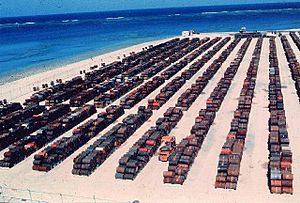
Agent Orange, a powerful herbicide, was brought to Johnston Atoll from South Vietnam and Mississippi in 1972. It was stored in an area called the "Agent Orange Yard." The Agent Orange was eventually destroyed in 1977 on a special incineration ship called the MT Vulcanus.
The U.S. Environmental Protection Agency (EPA) reported that a very large amount of Agent Orange was stored at Johnston Island. Leaking barrels and spills during storage caused pollution in the storage area and the lagoon.
Chemical Weapon Demilitarization
The Army built the Johnston Atoll Chemical Agent Disposal System (JACADS) on the island. This was the first large-scale facility designed to destroy chemical weapons by burning them safely. Planning for JACADS started in 1981, and it was completed in 1990.
From 1990 to 1993, the Army tested the facility to make sure it worked well and met all environmental rules. JACADS successfully showed that it could safely destroy all types of chemical weapons.
All the chemical weapons stored on Johnston Island were destroyed at JACADS. This process finished in 2000. After that, the facility itself was taken apart by 2003, and the island's remaining buildings were removed. The environment was also cleaned up.
Closure and What Remains
In 2003, most of the buildings and facilities on Johnston Atoll, including those from JACADS, were removed. The runway was marked as closed. The last official flight left the island on June 15, 2004. After this, the base was empty. Only a few structures were left, like the Joint Operations Center (JOC) building, some chemical bunkers, and a Quonset hut.
The JOC building was built in 1964. It is a strong concrete and steel building designed to survive hurricanes and nuclear tests. It has no windows and was emptied in 2004 during a cleanup project. Most of its doors have been welded shut.
The rows of bunkers in the Red Hat Storage Area are still there. However, they were filled with construction waste and debris and then sealed off with concrete blocks to prevent anyone from entering.
Contamination and Cleanup Efforts
Over the years, there were leaks of Agent Orange and chemical weapons in the storage areas. Chemicals were used for cleanup, and sometimes larger spills of nerve and mustard agents happened. The EPA also noted small releases of chemical weapon parts. Many studies have been done on the environment of Johnston Atoll, making it one of the most studied islands in the Pacific.
As part of the cleanup, contaminated buildings were taken apart. About 45,000 tons of soil with radioactive materials were collected and put into a fenced area on the north side of the island. This area was called the Radiological Control Area, but people often called it "The Pluto Yard" because it had a lot of radioactive plutonium. This area is where the 1962 missile explosion happened and where a highly contaminated loading ramp was buried.
After Closing
In 2005, the U.S. government briefly offered Johnston Island for sale. It was described as a "residence or vacation getaway" with potential for "eco-tourism." The sale would have included its own postal zip code. However, the island had no running water, electricity, or an active runway. The offer was later withdrawn.
On August 22, 2006, Hurricane Ioke hit Johnston Island. The center of the hurricane passed directly over the atoll with very strong winds. Twelve people were on the island at the time, working on a project to test groundwater pollution levels. All of them survived by taking shelter in the JOC building.
Since the base closed, many ships crossing the Pacific have visited the deserted atoll. Visitors have shared their experiences and photos online.
In 2010, a U.S. Fish and Wildlife survey team found an invasion of Anoplolepis ants on the island. These "crazy ants" are very harmful to native wildlife. The U.S. Fish and Wildlife Service started a project to get rid of them. By 2013, they had reduced the ant numbers by 99%, and they continue to work towards completely removing the species from the atoll.
Johnston Atoll has never had people living there permanently. However, in the late 20th century, about 300 American military personnel and 1,000 civilian workers were usually present at any given time.
Images for kids
See also
 In Spanish: Atolón Johnston para niños
In Spanish: Atolón Johnston para niños



